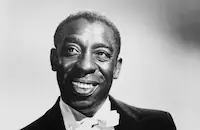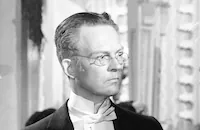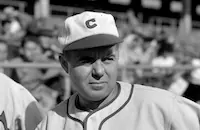The Las Vegas Story

Brief Synopsis
Cast & Crew
Robert Stevenson
Jane Russell
Victor Mature
Vincent Price
Hoagy Carmichael
Brad Dexter
Film Details
Technical Specs

Synopsis
On the train to Los Angeles, sophisticated Easterner Lloyd Rollins suggests to his wife Linda that they spend a few days in Las Vegas, her home town. Although reluctant to revisit her past, Linda agrees, and the couple disembarks in the desert city. Lloyd immediately starts gambling in the hotel casino, requesting a $100,000 credit limit, and insists that Linda show off an expensive diamond necklace he gave her. Linda, who has read a telegram addressed to Lloyd in which Monty, his Boston business associate, reveals that their company's trustees are demanding money, cautions Lloyd about gambling, but he dismisses her concerns. Unknown to Linda and Lloyd, they have been followed from the train by a man named Thomas Hubler, who watches Linda with interest.
Outside the hotel, meanwhile, Linda's embittered ex-lover, Dave Andrews, a sheriff's lieutenant, learns that Linda is in town with her high-rolling husband. Later that night, Lloyd encourages the distracted Linda to confront her past, and she goes to the Last Chance, the bar at which she used to sing. There, she recalls her wartime romance with Dave and reunites with pianist Happy and Mike Fogarty, the bar's former owner. As she and Happy perform a favorite old song together, Dave enters, then angrily reminds Linda that she did not say goodbye to him the night he shipped out. Although Linda insists that her failure was due to a simple misunderstanding, Dave refuses to forgive her, despite his continuing attraction to her. The next day, Hubler approaches Linda in the hotel swimming pool and expresses interest in her necklace.
Linda then tells Lloyd that she knows his credit request was limited to $10,000 and begs for a chance to help him with his financial troubles. Lloyd again shrugs off her concern and tries to act nonplussed when she relays a phone message that Monty has committed suicide. Drucker, who oversees the casino, then informs Lloyd that he cannot extend him additional credit based on the value of Linda's necklace and requests that he check out. Later, following an unpleasant encounter with Dave, Lloyd decides to visit the Last Chance with Linda before leaving Las Vegas. As he is exiting the hotel, he is accosted by Hubler, who identifies himself as an insurance investigator and demands to know where Linda's necklace is. Lloyd states that the necklace is in the hotel safe, but at the Last Chance, Hubler finds Linda and reveals that the necklace is missing. Furious, Linda questions Clayton, the Last Chance's owner, and he admits that he gave Lloyd $10,000 credit in exchange for the necklace. Disgusted with Lloyd, Linda leaves with Dave, and the two spend a romantic evening together at Dave's house. Meanwhile, at the Last Chance, a desperate Lloyd asks Clayton for more credit, but is refused.
At Dave's, Linda announces that she has to return to Lloyd, and Dave angrily calls her a taxi. Later, Dave learns that Clayton was murdered at the bar and Linda's necklace stolen. Because Hubler states that he saw Lloyd leaving the Last Chance at the same time that Clayton was killed, Lloyd is arrested. At Clayton's inquest, Linda declines to give Lloyd an alibi, but does offer to bail him out after he is arraigned. Hubler then informs Linda that he observed her leaving the Last Chance soon after he saw Lloyd depart and escorts her to the bar. There, in front of Happy, Hubler tests a confused Linda to determine whether she saw Clayton's body near the piano, then shows her a blood spot overlooked by the police. After Dave finds out that Linda was also at the Last Chance the night before, he talks with Happy, who repeats Hubler's claims that Clayton died near the piano. Aware that Clayton was found behind the bar, Dave suddenly realizes that Hubler killed Clayton for the necklace.
Dave telephones Linda to warn her about Hubler, but an armed Hubler has already appeared at her door. Hubler takes off with Linda in a rental car and, after the police set up a series of roadblocks, murders a tourist fishing at Lake Mead and steals his car. In a helicopter, Dave spots the stolen vehicle speeding along a desert road and forces Hubler into an abandoned airport. There, Dave and Hubler fight, and Dave finally corners Hubler on a tower and shoots him. Later, Dave gets word that the just-released Lloyd is being extradited to Boston on embezzlement charges and that Linda is filing for divorce and remaining in Las Vegas.

Director

Robert Stevenson
Cast

Jane Russell

Victor Mature

Vincent Price

Hoagy Carmichael

Brad Dexter

Gordon Oliver

Jay C. Flippen

Will Wright
Bill Welsh
Ray Montgomery
Colleen Miller

Robert Wilke
Syd Saylor
Boyd Cabeen
Steve Flagg

Clarence Muse
Oliver Hartwell
Wallis Clark
Dorothy Abbott
Joan Mallory
Jane Easton
Mavis Russell
Midge Ware
John Merrick
Pat Collins
Roy Darmour
Sam Finn
Joe Gilbert
Brooks Benedict

Don Dillaway
Robert Milton
Ward C. James
Don Blackman
Chet Marshall
Dick Ryan
Barry Brooks
Al Murphy
Paul Frees

Ray Walker
Jo Gilbert
Carolyn Block
Betty Onge
Helen Blizard
Mona Knox
Ralph Alley
Mitchell Rhein
Forrest Lederer
Charles Cross
Carl Sklover
Virginia Lynden
Connie Castle
Suzanne Ames
Annabelle Applegate
Joyce Niven
Shirley Tegge
Anne Dore
Chili Williams
Sylvia Lewis
Howard Darbeen
Milton Kibbee
George Hoagland
Roger Creed
Jimmy Long
Bert Stevens
Norman Stevans
Ben Harris
Ted Jordan
Philip Ahlm
Mary Bayless
Diana Mumby
Marg Darby
Barbara Freking
Barbara Thatcher
Beverly Thomas
Jean Corbett
Hazel Shaw
Sue Casey
Evelyn Lovequist
Betty Arlen
Jeane Cochran
Carole Morton
Crew
Harold Adamson
C. Bakaleinikoff
Mel Berns
Samuel Bischoff
Hoagy Carmichael
Albert S. D'agostino
Howard Darbeen
Jay Dratler
Harry Essex
Earl Felton
Fred Fleck
Larry Germain
Les Goodwins
Feild Gray
Howard Greer
Leigh Harline
Howard Hughes
Paul Jarrico
Frederic Knudtson
Paul Mantz
Clem Portman
Sam Ruman
George Shrader
Darrell Silvera
Robert Sparks
John Sturtevant
Harold Wellman
Harry J. Wild
Earl Wolcott

Photo Collections
Videos
Movie Clip



Trailer
Hosted Intro
Film Details
Technical Specs

Articles
The Las Vegas Story
In the early 1950s RKO chief Hughes had begun to have a financial interest in the gambling resort city Las Vegas, Nevada, so he had producer Robert Sparks make a film that would glamorize the city in its title and backdrop. Jay Dratler wrote the story, which was also meant to feature Hughes' favorite leading lady of the period, Jane Russell. This was then fashioned into a screenplay by three writers: Earl Felton, Harry Essex, and Paul Jarrico. In the film, Russell plays Linda, a former cafe singer. She has just married Lloyd Rollins (Vincent Price), an investment broker from New York. Linda is reluctant to travel with him to Las Vegas; she has not told him of her past in that city. When she was a singer at the Last Chance Club, she had fallen in love with Dave Andrews (Victor Mature), who left the country without her. Rollins is hoping to make a windfall in Vegas, but he only manages to fall deeper into debt. When he is accused of stealing his wife's expensive necklace to use to keep gambling, Andrews, now a police lieutenant, investigates. Andrews uncovers the real thief, Tom Hubler (Brad Dexter).
In April of 1951, screenwriter Paul Jarrico was brought before the House Committee on Un-American Activities (HUAC), and pleaded the Fifth Amendment, refusing to testify. His current film in production was, in fact, The Las Vegas Story at RKO, where he was a contract employee. Hughes, a fervent anti-Communist, fired Jarrico and planned to take his name off the credits of the film. This action would be in direct violation of the rules of the Screen Writers' Guild, which stated that no writer should be denied credit on a picture if they had contributed 30 percent or more to a given script. The members of the Guild threatened a strike if Hughes went ahead with his plans. According to Charles Higham in Howard Hughes: The Secret Life, "Hughes issued a statement saying, 'They might as well get on with it.' He railed at his staff that anyone who joined or supported the strike would be fired at once." The president of the Guild, Mary C. McCall Jr., said "Mr. Hughes has thrown a mantle of Americanism over his own ragged production record." When the Guild attempted to arbitrate the matter, Hughes refused to budge, and won a judgment in California Supreme Court that recognized his right to remove the credit because Jarrico had violated the "morals" clause in his RKO contract. The Court also ruled that the Screen Writers Guild did not have the power to compel Hughes into arbitration. This threw the primary function of the Guild's present agreement with the Association of Motion Picture Producers into jeopardy.
In Naming Names, Victor S. Navasky points out that the Screen Writers Guild, although it had a strong "progressive" faction, was primarily engaged at the time in distancing the body as a whole from charges of Communism. "...By the end of 1947," Navasky writes, "although it was a vocal critic of HUAC's practices, it had accepted Section 9H of the new Taft-Hartley labor law, which required officers of all trade unions to sign a non-Communist oath, purged its committees of Communists, and abandoned the Hollywood Ten." The SWG was apparently more insistent on protecting its core function - to arbitrate credits - so when Hughes attempted to circumvent the process with The Las Vegas Story, the Guild fought back. After the Hughes judgment, the Guild met with the Association of Motion Picture Producers. An agreement came out of that meeting in 1952 which would have quite an effect on the films of the era and the fates of the writers who had been put out of work by the blacklist. As Navasky explained the agreement, "...to preserve the right to arbitrate credits in general, SWG ceded the producers the right to take away credits for political 'crimes.'" As a result, producers were more inclined to use blacklisted writers, working through "fronts," on their films. "No longer need the producer fear that a black-market writer would blow his cover and insist on his credit, to the embarrassment - and possible financial detriment - of the studio. Activity on the black market picked up..." Navasky went on to point out, however, that "in a land where credit is all," the new practice did not result in revived careers or a vast improvement in the lives of those blacklisted. The amendment which referenced Communist affiliations stayed in the SWG contract when it came up for renewal in 1955, and wasn't actually removed until 1977. By then, many of the blacklisted screenwriters who had worked for years "under the table" had their names properly recognized on the films to which they had contributed.
What then, was said in 1952 of the job that Jarrico and the other writers actually did on The Las Vegas Story? "Brog" in Variety summed it up nicely, saying that the "principal point against [the] film is the obscure motivations of plot principals. A little more light on the subject would have helped but scripters and direction apparently prefer to keep both audience and players in the dark." The film does spring to life during the musical sequences and during a climactic chase scene which is exciting and expertly staged. Featuring perhaps the first example of a car/helicopter chase sequence on film, the stunt work, cutting, and pacing are worthy precursors to many later examples, such as those appearing in James Bond films of the 1960s.
The musical numbers in The Las Vegas Story enliven the proceedings as well. Hoagy Carmichael appears as "Happy," and he provides three songs for the film: "I Get Along Without You Very Well," sung by Russell; the sprightly novelty number "The Monkey Song"; and "My Resistance Is Low," performed by both Jane and Hoagy. The drama of the film fares poorly by comparison, however. Writing in The RKO Gals, James Robert Parish said that "director Robert Stevenson brought out all the minus-values in Jane [Russell], permitting her to render a most unrelaxed performance. Her scenes with Mature seemed more appropriate to something out of Zombies on Parade."
Producer: Robert Sparks, Howard Hughes
Director: Robert Stevenson
Screenplay: Paul Jarrico, Earl Felton, Harry Essex, Story by Jay Dratler
Cinematography: Harry J. Wild
Film Editing: Frederic Knudtson, George C. Shrader
Art Direction: Albert S. D'Agostino, Field Gray
Music: Leigh Harline
Costume Design: Howard Greer
Special Effects: Harold Wellman
Cast: Jane Russell (Linda Rollins), Victor Mature (Lt. Dave Andrews), Vincent Price (Lloyd Rollins), Hoagy Carmichael (Happy), Brad Dexter (Tom Hubler), Gordon Oliver (Mr. Drucker), Jay C. Flippen (Captain H. A. Harris), Will Wright (Mike Fogarty)
BW-88m.
by John M. Miller

The Las Vegas Story
Quotes
Trivia
Notes
The working title of this film was The Miami Story. According to a Hollywood Reporter news item, the title was changed after RKO dropped plans to shoot some of the picture in Florida. The film opens with voice-over narration spoken by Hoagy Carmichael as his character "Happy."
Contemporary news items add the following information about the film's production: In December 1948, Warner Bros. purchased Jay Dratler's original screen story and hired him to produce the picture. Burt Lancaster was announced as the film's star in April 1949. RKO acquired the rights to Dratler's story in January 1950 and signed Dratler to produce, write and direct. Robert Mitchum and Robert Ryan were each announced as the film's probable star in various news items in January 1950. In November 1950, Samuel Bischoff took over as producer and Victor Mature was cast as the male lead. RKO borrowed Mature from Twentieth Century-Fox, whose contract with the actor required that he appear in one RKO film per year. In order to get out of appearing in one particular RKO picture, Mature reportedly feigned an injury and was suspended for several weeks just prior to being cast in The Las Vegas Story. Robert Stevenson was hired as director in mid-December 1950. Ed Begley was announced as a cast member in early May 1951, but he did not appear in the picture. Rudy Germaine was also cast, but his appearance in the final film has not been confirmed.
Location shooting took place in Las Vegas, NV, at the Moroc Naval Air Base near Mojave, CA, and in the Mojave Desert. Colleen Miller, a Las Vegas chorine who was reportedly "discovered" during production and given an RKO contract, made her screen debut in the picture. Although Hollywood Reporter announced in July 1951 that songwriter-actor Hoagy Carmichael would also compose the film's score, only Leigh Harline is credited onscreen as composer. The film's extravagant Las Vegas opening benefitted the Heart Fund of the Variety Clubs of America. Modern sources note that the picture lost $600,000 at the box office.
Although not credited onscreen, Paul Jarrico co-wrote the film's screenplay with Earl Felton and Harry Essex. According to a March 19, 1952 Daily Variety news item, RKO head Howard Hughes ordered that Jarrico's credit for this film be removed because Jarrico had been blacklisted in 1947 after refusing to cooperate with the House Committee on Un-American Activities. The Daily Variety item and a March 1952 Los Angeles Examiner item note that in July 1951, RKO advised the Screen Writers Guild that it was planning to remove Jarrico from the screen credits, claiming it had discarded all of his work on the script and hired new writers to reformulate the story. However, in September 1951, the Guild, after analyzing the script according to standard Guild criteria, ruled that Jarrico deserved a co-screenwriting credit. On March 18, 1952, in response to Jarrico's public accusation that Hughes had breached his contract by depriving him of his writing credit, RKO filed a lawsuit for "relief from Jarrico's demand for screen credit or a $5,000 settlement." The matter also was considered by a six-man conciliation commission formed by the Screen Writers Guild as part of its pact with the major studios, according to the Daily Variety item. Superior Court Judge Orland H. Rhodes eventually ruled that RKO was within its rights in denying Jarrico's screen credit; in October 1954, Rhodes's decision was upheld by the District Court of Appeals.
According to a 1998 Hollywood Reporter article, Jarrico's credit for The Las Vegas Story was officially restored by the Writers Guild of America West in July 1998, along with credits for three other films, Universal's 1957 release The Girl Most Likely , Paramount's 1960 film Five Branded Women and the 1963 Rank picture All Night Long (see AFI Catalog of Feature Films, 1961-70). Jarrico, who became the leader of the Guild's Blacklist Credits Committee, which undertook to restore credits for blacklisted writers, died in a car crash nine months before the Guild's restoration of his own credits.
















